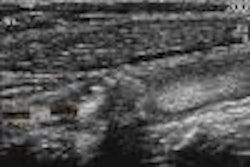ATLANTA - Regardless of palpability, thyroid nodules classified as positive on ultrasound should undergo fine-needle aspiration, according to investigators from Yonsei University and Severance Hospital in Seoul, South Korea.
In a poster presentation Tuesday at the American Roentgen Ray Society meeting, Dr. Eun-Kyung Kim and colleagues outlined new sonographic criteria for fine-needle aspiration biopsy after prospectively reviewing 155 ultrasound scans in 132 patients. Traditionally, size has been the main criterion for categorizing nonpalpable nodules. Nodules smaller than 1.5 cm were followed by palpation, which could result in a missed lymph node metastasis or extranodal invasion.
The researchers used an HDI 3000 scanner (Philips Ultrasound, Bothell, WA), along with electronically focused near-field probes with a bandwidth of 7-12 MHz.
Microcalcifications, irregular or microlobular margins, marked hypoechogenicity, and a taller rather than wider shape were considered suspicious sonographic features. If one of these features was present, the nodule was classified as positive.
The final diagnosis in 106 benign lesions and 49 malignant lesions as determined by ultrasound was confirmed with fine-needle aspiration biopsy and follow-up of six months or longer.
Of the 182 lesions classified as positive on ultrasound, 46 were malignant. Of the 73 lesions deemed negative, there were three false negatives. The sensitivity of ultrasound was 93.8%, the specificity was 66%, the positive predictive value (PPV) was 56%, and the accuracy was 74.8%, according to the authors.
Sonographic findings could help surgeons decide the optimal method for managing nonpalpable thyroid nodules, they wrote. This criterion sets out a new algorithm for thyroid nodules: If a thyroid nodule meets even one criteria for malignancy, regardless of the lesion size, fine-needle aspiration should be performed.
In a study published in Radiology, Dr. Antti Brander and colleagues from Helsinki University Central Hospital in Finland came to a similar conclusion regarding the usefulness of ultrasound.
Their study sought to clarify the natural history of nonpalpable lesions detected by ultrasound in a random adult population.
Among 253 randomly selected adults, abnormalities were detected by ultrasound in 27% of the cases. In the follow-up study, 83% of those 69 subjects were reexamined with ultrasound, fine-needle aspiration biopsy (FNAB), blood tests, and clinical examination. Eight nodules (24%) had diminished or disappeared, while seven new focal lesions were found in seven subjects (12%).
Biopsy was performed in five of these lesions, and they were benign. At a 5-year follow-up, no thyroid malignancies were detected among subjects with echo abnormalities at the primary US screening (Radiology, June 2000, Vol.215:3, pp. 801-806).
These studies should bolster the case for ultrasound in thyroid imaging, which has been questioned of late.
Investigators from the department of otolaryngology-head and neck surgery at the University of Virginia Medical School in Charlottesville compared the effect of ultrasound, thyroid scintigraphy, and fine-needle aspiration biopsy on final surgical pathology. They found that ultrasound had an accuracy of 32%, versus 86% for fine-needle aspiration biopsy, and concluded that imaging yielded too many false-positive results (Ear, Nose, & Throat Journal, March 2002, Vol.81:3, pp. 151-154).
By Shalmali Pal
AuntMinnie.com staff writer
May 1, 2002
Related Reading
UK guidelines aim to reduce thyroid cancer mortality, March 26, 2002
Therapy-eluding metastases caught with FDG-PET, October 3, 2001
Ref3 I131 thyroid cancer, August 29, 2001
Risk of thyroid cancer doesn’t hinge on nodularity, April 17, 2001
Copyright © 2002 AuntMinnie.com



















